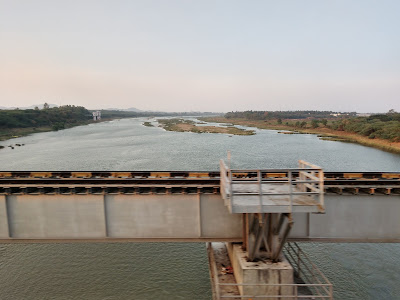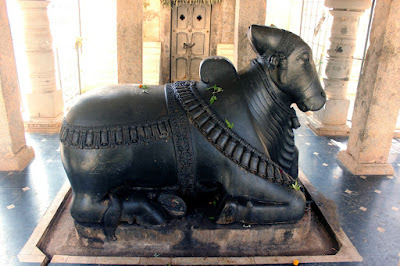...continued from a taste of rural life at Bhogasandra part-1a.
Feb 9th. Morning chill was consistent. The reason behind chilly-misty mornings are Bhogasandra Kere and the stream. A very few people get out of bed before 7 am. That doesn't mean they are lazy. By 7-30 most people in their plantations, coconut or arecanut or both. Purpose of the visit could be a general check, if the drip irrigation pipes & electrical gadgets are intact, to take an approx count of grounded coconuts or to collect arecanut sheaths. As per folks here, there are no cases of thievery in & around Bhogasandra yet it's every property owner's duty to check. Ripe coconuts fall on their own, one needs to have an estimate to have them picked up and sent to coconut storage pens. Arecanut trees shed sheaths which are used to make plates and cups which have a good demand. They are ecofriendly use-n-throw stuff. The collected & stored sheaths are later sold to plate-making factories.
For the third consecutive day, breakfast was hot upit. Sridhar and I are okay eating the same stuff day after day... homemade stuff is better than eating packed food. Only the carpenter was expected that morning, team arrived promptly at 10 am and began their work. I think the painting team came around 11-30.
Around 12-15 pm, we headed towards Shivappa's home. We took the shortcut path which went along the farm's fence right upto the stream. Sridhar's property includes the trench seen here. It was made to drain excess water from the plantation.
Shivappa met us at the stream to guide us wade across the stream. This stream flows through a valley, the valley being the border of two gramas Bhogasandra and Hosakere. Wading through a stream can be a tricky thing, here a series of stones made it easy. If not for the stones, with every step our feet would sink into mud and pulling it up would've required some effort. After a good rain, water level would be much higher, crossing the stream won't be that easy. I must come here during a rainy season and see the fast slowing water.Two or three buffaloes were hanging around, one immersed in water with its snout and spine sticking above the surface. It looked like a crocodile in water. It was looking at us suspiciously ...who are these strangers? why are they here?
Buffaloes are wary of strangers, some start staring. This buffalo standing on the peninsula was staring at me. I think they behave that way because of body odor which is heavily laced with perfume of soaps & deodorants. Even our clothes carry the smell of detergent which is much stronger.
It was uneventful journey. This picture was taken near Karajgi station.
Buffaloes are wary of strangers, some start staring. This buffalo standing on the peninsula was staring at me. I think they behave that way because of body odor which is heavily laced with perfume of soaps & deodorants. Even our clothes carry the smell of detergent which is much stronger.
I liked this spot because it has a feel of wilderness. Clumps of wild grass, date palm, pools of water created a nice ambiance.
This feels like an oasis.
Sridhar and Shivappa rest in the shade. I explore the surroundings a bit. A rocky mound behind me was interesting. The mound which looked pristine when viewed from this house was hacked away on the other side. I think mud and stone was being quarried illegally. Uncontrolled quarrying is one of the banes of our country. It disturbs the ecological balance ...removing green cover and exposing soil, altering water flow during rains. The pristine side of the mound was Shivappa's kitchen garden. There were some Avarekayi creepers. Avarekayi season was coming to a close, I couldn't spot any beans as such. I needed a break from sunlight, joined the group in the shade. I asked Shivappa to get us some Avarekai if he could find them. A plan to make Avarekain upit was spinning in my mind.
Our host brought in refreshments- slices of apple and cups of sweet curds. Then we headed towards another plantation of Shivappa, a few minutes walk away.
Shivappa had already plucked a few tender coconuts for us. Using a machete he opened them for us. Water and tender flesh were refreshing.
This feels like an oasis.
Shivappa's house is situated at the edge of his coconut plantation. Compared to Sridhar's farm, this is at a higher elevation, has an unhindered view of the lands across the stream. These two bougainvillea vines flank the entrance to Shivappa's property. Had we driven here we would be entering from this side.
Shivappa with his younger grandson posing next to Kanagali Gida, Oleander plant. Shivappa is quite an enterprising person but keeps a low profile. He is always busy, so is his son. He is one of the few people here who doesn't indulge in idle chitchat.Sridhar and Shivappa rest in the shade. I explore the surroundings a bit. A rocky mound behind me was interesting. The mound which looked pristine when viewed from this house was hacked away on the other side. I think mud and stone was being quarried illegally. Uncontrolled quarrying is one of the banes of our country. It disturbs the ecological balance ...removing green cover and exposing soil, altering water flow during rains. The pristine side of the mound was Shivappa's kitchen garden. There were some Avarekayi creepers. Avarekayi season was coming to a close, I couldn't spot any beans as such. I needed a break from sunlight, joined the group in the shade. I asked Shivappa to get us some Avarekai if he could find them. A plan to make Avarekain upit was spinning in my mind.
Our host brought in refreshments- slices of apple and cups of sweet curds. Then we headed towards another plantation of Shivappa, a few minutes walk away.
Shivappa had already plucked a few tender coconuts for us. Using a machete he opened them for us. Water and tender flesh were refreshing.
Time to head back to the base. We took another route where the stream was narrow. Here we could see flowing water. The sound of water gurgling in the silent surroundings was soothing. This spot where we crossed over seems like a perfect place for wild animals to quench their thirst.
We trekked through a neighboring farm. These 40' to 60' arecanut trees must be 10 to 12 years old. They usually start yielding in the 7th or 8th year provided they were well cared.
Back at the lodge, we prepared rice and had it with lemon and tomato rice powder. I think we had some sprouts as well. I tried napping but it was a bit too warm for comfort. As usual we had a round of tea around 4-30 pm. I decided to go out for a walk and shoot a few pictures while it was still bright. My first shot was this shed in the neighbor's farm, stones throw from our lodge. This little structure built out of roughly shaped blocks is beautiful, good workmanship. A few feet away from the stone shed was this snake skin. This must be quite recent. If its older than a week bits and pieces would've gone missing.
I ventured further away, took the path going towards the jungle. I took another look at the Hibiscus trees, took a few shots with the zoom lens. By then sun was out of sight, it was getting dimmer by the minute. Continued walking and turned into a footpath on my left. This patch of land were uncultivated, meaning no plantations, semiwild where shepherds grazed their flocks. I could get a few clear shots in poor light.We had planned to attend the evening pooja at Siddalingeshwara Devastana. As before we chitchatted with familiar folks and got introduced to new faces. The breeze blowing over the lake water was cold, and fortunately breeze was on and off. For the evening, kettle drums were brought in to be played during the pooja. Prasada was distributed soon after Mangalarati. I can't recall the menu but anything prepared as Pooja Prasada have always tasted great.
Feb 10th. Time to leave Bhogasandra and return home. The original plan was that both of leave together. A small change in plan. Sridhar had to stay back because of the ongoing work. He was working hard to complete all major works before the month end. Sridhar had engaged his regular autorickshaw guy Anand for the morning. In northern Karnataka, diesel powered autorickshaws are called tumtum because of its peculiar exhaust note. The ride was quite smooth, it was a 2YO vehicle.
Anand dropped me off at Nittur KSRTC bus-stand by noon. Within a minute I boarded a bus going towards Tiptur. As usual I sat in the last row, alone. The bus's rear end would bounce off speed bumps but I would be prepared for it by lifting up from the seat, and let my legs absorb the shock like a spring. The bus reached Tiptur bus-stand by 1-15, then a 15 minute walk to Tiptur railway station. I was on the platform by 1-30 and my train was expected at 2-40 pm. The platform was free, shaded and clean, it was breezy, I parked myself on a stone bench, took off shoes and relaxed. I was carrying sprouts for lunch, I munched them slowly. The train arrived on time. Passed Davangere around 5-45 pm. This is a silhouette of Bathi hill. On its eastern slope is Sri Revana Siddeshwara Devastana, a historic temple renovated recently.
A few minutes before 6pm the train crossed Tungabhadra, the river which demarcates southern and northern Karnataka. The next major place in the river's path is Hospete.It was uneventful journey. This picture was taken near Karajgi station.
Train arrived at Hubballi as per schedule. A short walk from the platform to BRTS terminal. I was home by 9-45, a nice and warm food, and a good sleep. Home sweet home.
.........








































































